The Brass Fish Figure found at Blenden Hall, Inaccessible Island
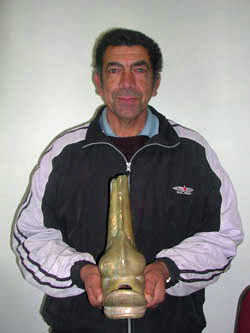 |
Jack's DiscoveryJack Green is shown left holding the figure in a photograph provided by his wife Cynthia who is the Administrator's Secretary. Jack found the figure at the landing site on the boulder beach at Blenden Hall on 24th March 2007 when visiting with Conrad Glass (Head of Tristan's Police Department and now Chief Islander), Mark Swain, Warren Glass and Clive Glass). It was buried under stones, with a small piece sticking out. Jack's father, Nelson Green was a leading Tristan da Cunha boatman, and acted as one of the guides to the 1982/3 Denstone Expedition to Inaccessible Island which produced the first land survey of the island and catalogued its geology, fauna and flora. The expedition built a hut above the beach at Blenden Hall which served as their expedition base and gave access to the 'West Road', Inaccessible's only safe path to reach the mountainous interior of the island. |
|
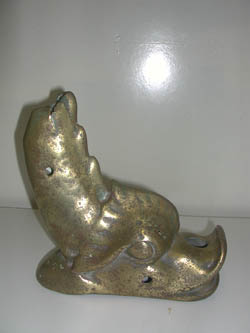 |
Vital facts about the fish figure: |
|
| When was it found? | 24th March 2007 | |
| Who found it? | Tristan da Cunha islander Jack Green | |
| Where was it found? | Buried amongst boulders on Blenden Hall beach on the north-west coast of Inaccessible Island | |
| How big is it? | 23cm long by 24cm high | |
| How much does it weigh? | 3.035kg | |
| What is it made of? | Brass | |
| What exactly is it and where did it come from? | See below | |
Possible Identification
Update from Peter Millington, 20th July 2022
Despite the decidedly fish-like scales and fins, British antique dealers call this a 'stylised dolphin'. Such ornamental 'dolphins' have a long history in Europe, going back to Ancient Greek and Roman times, where they were often depicted being ridden by the god of love Eros or Cupid. However, from the 18th century onwards, they have been a popular motif for any object requiring an ornamental support. For instance, brass 'dolphins' were used in candlesticks, doorstops, paper weights, etc. However, given the context of Jack's find, I think it most likely that his 'dolphin' came from the supporting framework of a ship's bell - presumably the Blenden Hall's bell. The examples pictured below show that the design is fairly common, and indeed they are still being cast today. They make a nice present for retiring sea captains.
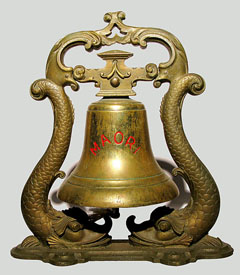 |
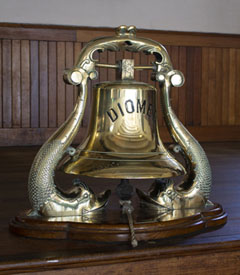 |
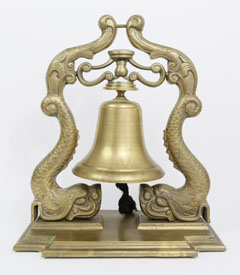 |
| Photo: NZ Museums | Photo: Victorian Collections | Photo: Rafael Osona Auctions |
Blenden Hall's first and most famous wreck
Blenden Hall is named after Tristan da Cunha's most famous wreck of the 450 ton East Indiaman Blenden Hall on 23rd July 1821. In calm but misty conditions, the ship became stuck in the thick kelp which surrounds the islands and swept ashore by the strong current. Two sailors drowned as the passengers and crew used lifeboats and a makeshift raft to rescue the rest of the passengers and crew who scrambled ashore, many with injuries sustained in the process, They survived mainly on sea birds and their eggs for over three months. A first attempted sailing to Tristan da Cunha in a makeshift craft failed as six further crew members were lost at sea, but in a second attempt on 9th November a group managed to reach Tristan da Cunha and in the next few days islanders managed to rescue the remainder of the survivors who were shipped to the tiny Tristan Settlement (of about 16 people, including William Glass, his wife Maria (the only woman) and five Glass children). The arrival of about 50 newcomers stretched food supplies and caused hardship in the small community until all but two of the survivors secured a passage to The Cape in January 1822.
There are records of some goods salvaged from the Blenden Hall wreck, including mahogany, but also of other visiting ships coming ashore and helping themselves to the wreckage (eg the schooner Dart is alleged to have taken away blocks and ropes stored in huts built ashore.). So was the Blenden Hall itself the source of this brass figure. Could it have escaped the beachcombers and lie undetected for 186 years on the wild Blenden Hall beach?
Selected correspondence and useful web links will be published here as we receive them.
Please send any clues to tristandc.com's website manager Richard Grundy on newseditor@tristandc.com
The prize will be awarded on receipt of a genuine identification.
